Opal Dream
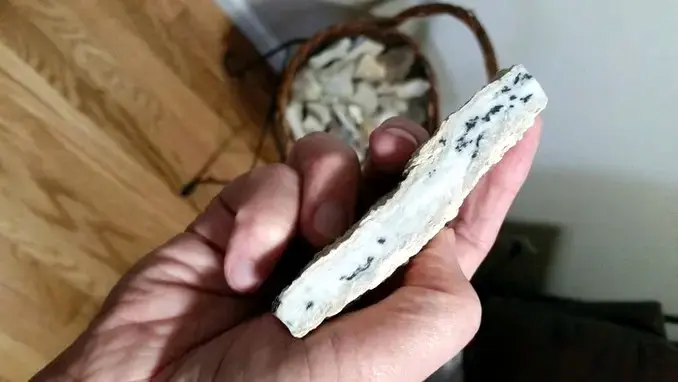
- Behold The Opulent Opal Adorned With Manganese Dendrites
Guess what? The moment I’ve been dreaming of since my youth has finally arrived! The one thing I sought while hunting deer, rocks, uranium, and having wild adventures in my younger days—and continued to search for while exploring the desert with my children—I’ve found it!
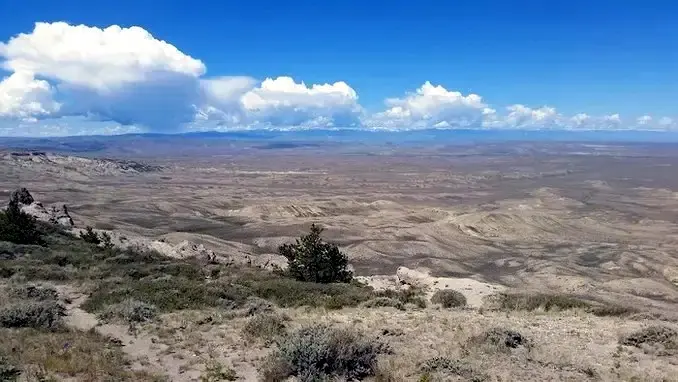
- Isn’T It Just The Right Stuff?
As an exploration geologist, I knew where to look for it, but opal had a way of playing hide and seek with me. Until one day, just before the season’s first significant snowstorm, I stumbled upon a few opal stringers during a late afternoon outing.
No trails, no signs of digging, not a hint that anyone had crossed this path before me. Now, that’s unusual. Wyoming’s historical rock collecting sites have been raided over the years, and some are now claimed by those who probably confuse ‘could’ with ‘should.’ Yet, this spot remains untouched.
And let me tell you, it’s breathtaking. Picture a 6 to 15-foot layer of interbedded tuff, featuring translucent clear to coffee chalcedony, milky white to translucent common opal with manganese inclusions, and some secondary crack-filling with clear, uraniferous chalcedony.
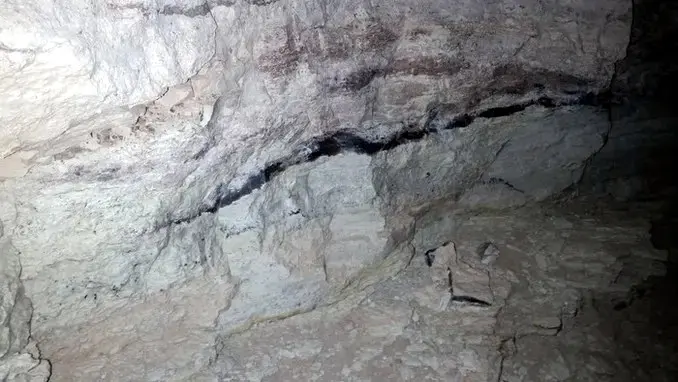
- Behold The Ledge, The Seam, And Several Specimens Ready For Tossing
The next night, armed with my trusty new long-wave LED flashlight, I was back at the outcrop. The fluorescence was so mesmerizing that I found myself clambering down the cliff to a loose, narrow ledge on top of the talus, working along the contact. I’ve never witnessed a fluorescent wall like this before.
I attempted to capture the brilliance in photos, but the relentless wind had other plans. Not even the old hand-on-rock, UV flashlight in the mouth, and camera in the other hand trick worked. LOL
While the footing was precarious, I managed to toss a few specimens back up over the cliff without tumbling into the black abyss. So, here they are:
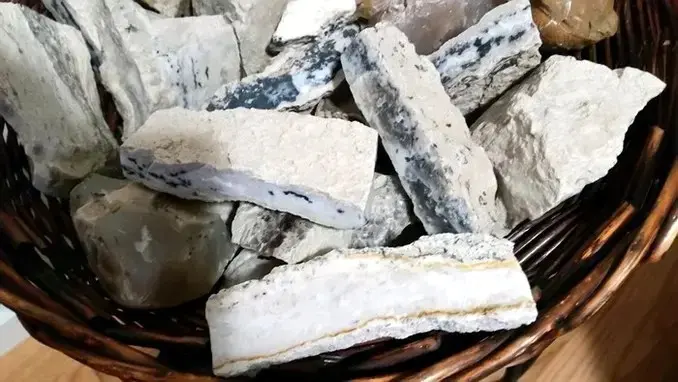
- Check Out These Hand-Sized Specimens In Their Natural Light
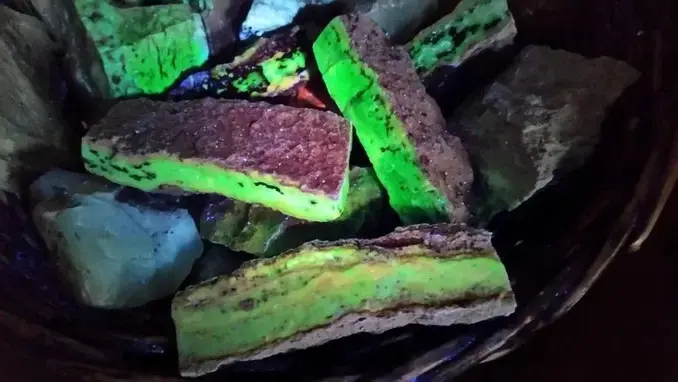
- Same Specimens, Now Illuminated With Long Wave UV And Natural Light
The fluorescent aqua, light orange, and deep green colors gracefully transition into very bright greens that beautifully contrast with the dark, non-fluorescent manganese. Occasionally, you’ll spot bright greenish-yellow fluorescent chalcedony filling some cracks. The non-fluorescent white tuffaceous matrix absorbs all the light from the lamp, appearing dark chocolate to coal black.
This opal is radiant even under long-wave with natural light. When illuminated with shortwave ultraviolet light, they glow with a uniformly extremely bright uranium green against a black background. It’s brighter, but not nearly as fascinating as when bathed in the magic of the 365nm LED flashlight.
In a break in the weather, I made my way back to the outcrop. The journey was typical for this time of year, but the environment was downright brutal, with temperatures below 20 degrees and winds gusting well above 60 mph. That’s no fun. So, I quickly retreated.
The next storm is poised to block access until the snowdrifts melt and the mud holes dry up next spring. With only a small section of the outcrop examined, more adventures await in better weather come June.
The Backstory
Let’s rewind a few decades. Back then, I was a free-spirited child cruising on my bicycle among 4,000 western desert people. And among them, two stood out.
First up is Cliff Hopkins, an elderly businessman with a basement that could rival any treasure trove. Amidst crates of thunder eggs, fluorescent minerals, agates, and petrified wood, his true passion stood out—Australian opal. Thanks to Cliff’s generosity, I got my hands on a specimen that could easily rival anything adorning a $5K opal ring today. Cliff also introduced me to my first 3-watt shortwave ultraviolet light.
Living just a block away was Pete Todd, running a commercial lapidary business. Pete was the source of a slice of milky, translucent common opal. It may have lacked precious opal’s fire, but boy, was it the brightest fluorescent specimen I’d ever seen. Its bright green fluorescence could easily match sodalite’s brilliant orange fire. Even with a 3-watt UV lamp, it left me in awe.
Back then, Australia felt like a world away. Realizing my dream of digging an earth-sheltered home and mining opal at Coober Pedy seemed like a distant fantasy. But discovering some bright green, glowing Wyoming opal? That was a real possibility. Thus began a decades-long dream and the search.
White common opal, porcelain-like in appearance, was discovered 20 miles south of town. It glowed a brilliant blue-white and occasionally housed a few manganese dendrites. I’d ride my bike out there and collect some. Other pieces of common opal were collected during deer hunting. Back then, it was considered worthless. Decades later, this same opal was overhyped by the WGS, sparking an opal rush.
Is my quest for opal complete with this recent find? Not quite. This opal is similar and, in some ways, more intriguing, but less translucent and a shade dimmer than those from Pete Todd. It’s undoubtedly from the same formation and processes. However, this is a different location; otherwise, Pete Todd and other rockhounds would have unearthed it.
And what about those first opal specimens? I held onto that Australian opal until I moved to Florida. Unfortunately, I have no clue what happened to it. It’s gone. :(
I still have a small thumb-sized piece of that Wyoming opal pie slice, but most of it has vanished with time. As a child, I split it in half to see what was inside. Other portions were given away, and at one point, tired of lugging around large specimens, I downsized my collection to walnut-sized rocks.
Update
A glance down a garden pathway, where I casually toss interesting pebbles collected along the way, revealed it. A thumb-sized chunk of a very distinctive rock. Yep, it’s a distinctive rhyolite from Mexico. And I recognized it as a piece of a precious fire opal specimen.
Now, I know what happened to that lost Australian opal, along with some other fire opal and gold specimens.
Decades ago, my sister-in-law, a teacher, needed some rock specimens to enhance her class. At the time, I was downsizing my collection and gave her several boxes of extra rocks wrapped in newspaper. Apparently, the opal and gold specimens, also wrapped in newspaper, were inadvertently put in the wrong box.
Recently, she returned the remnants of those rocks. I looked at the battered fragments and dumped them in the pathway. That’s how the rhyolite got there.
There’s no sign of any remaining precious opal or gold. They’ve likely found their way into someone’s pocket. I hope they inspired some children, just as they inspired me. And that, my friends, is the best purpose a rock can serve.
Rock on and dream big! ✨
Cheers, D 🪨🔥
